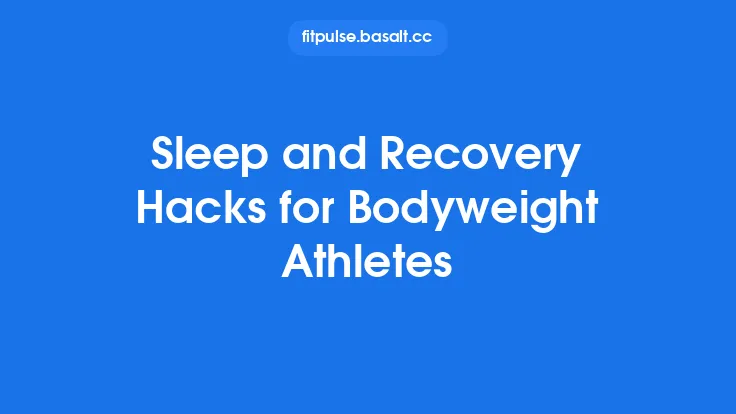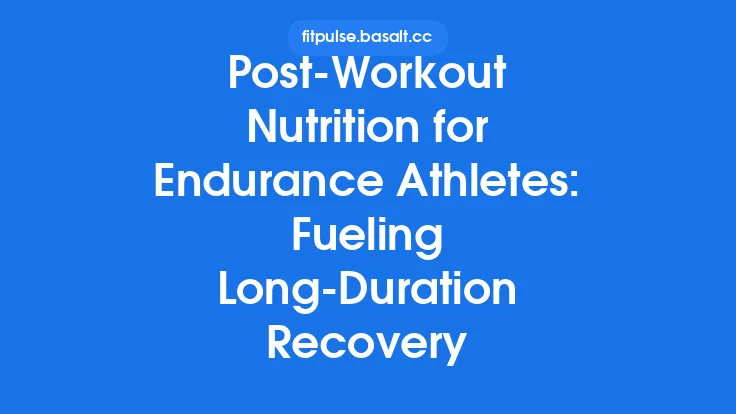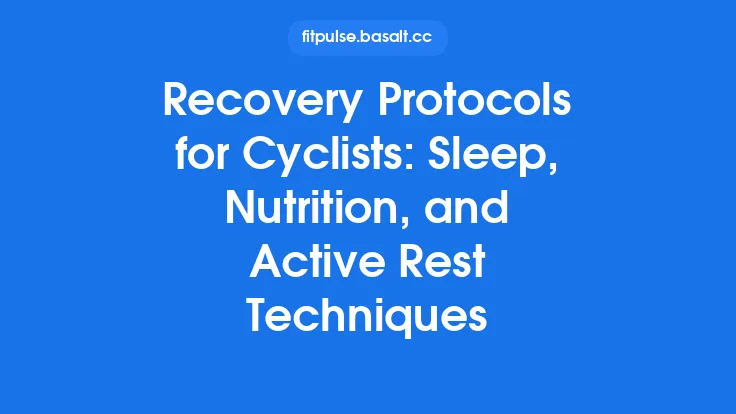After a demanding training session, the body craves a transition from the high‑intensity state of effort to a calmer, reparative mode. While a simple cool‑down jog or a few static stretches can help, a thoughtfully crafted yoga flow offers a uniquely holistic pathway to active recovery. By blending gentle movement, targeted lengthening, breath‑synchronised pacing, and mindful awareness, yoga can accelerate the removal of metabolic waste, restore optimal muscle length, and re‑engage the nervous system’s parasympathetic branch—all without compromising the training adaptations you’ve just earned. Below, we explore the science behind post‑workout yoga, outline the principles that make a flow effective, and provide a complete, adaptable sequence you can slot into any training regimen.
Why Yoga Is Ideal for Post‑Workout Recovery
- Integrated Musculoskeletal Reset
Yoga combines low‑load, multi‑planar movements that address both the contractile (muscle fibers) and non‑contractile (fascia, tendons) components of the musculoskeletal system. This integrated approach promotes balanced tension release, reducing the risk of localized tightness that can evolve into overuse injuries.
- Enhanced Venous Return and Lymphatic Drainage
The rhythmic, flowing nature of yoga poses—especially those that incorporate inversion or gentle compression—facilitates venous return to the heart and stimulates lymphatic flow. This accelerates the clearance of lactate, hydrogen ions, and inflammatory cytokines that accumulate during high‑intensity work.
- Autonomic Nervous System Modulation
Coordinated breathwork (pranayama) and sustained postures activate the vagus nerve, shifting the autonomic balance toward parasympathetic dominance. The resulting drop in heart rate and cortisol levels supports tissue repair and mental relaxation.
- Proprioceptive Re‑Education
Even after fatigue, yoga challenges joint position sense and neuromuscular control through mindful alignment cues. This reinforces motor patterns, helping athletes maintain technique quality in subsequent sessions.
Physiological Benefits of Yoga After Intense Training
| System | Primary Effect | Mechanism |
|---|---|---|
| Muscular | Reduced residual tension, improved extensibility | Myofascial elongation via sustained holds (30‑90 s) and gentle traction |
| Cardiovascular | Lowered heart rate, improved stroke volume | Slow diaphragmatic breathing (4‑6 breaths/min) stimulates baroreceptor reflex |
| Metabolic | Faster clearance of metabolic by‑products | Enhanced capillary perfusion from dynamic transitions (e.g., cat‑cow) |
| Neuroendocrine | Decreased cortisol, increased oxytocin | Parasympathetic activation through breath‑body synchrony |
| Psychological | Elevated mood, reduced perceived exertion | Mindfulness component reduces rumination on fatigue |
Key Principles for Designing a Post‑Workout Yoga Flow
- Prioritise Low‑Load, High‑Duration Holds
After heavy loading, the muscles are already fatigued. Opt for poses that require minimal strength but allow for prolonged stretching (e.g., seated forward folds, supine twists).
- Maintain a Gentle, Rhythmic Pace
Transition between poses with fluid, controlled movements rather than abrupt shifts. This preserves the warm‑muscle state while encouraging circulation.
- Incorporate Bilateral Symmetry
Balance the workload on both sides of the body to prevent compensatory patterns that may have emerged during the primary workout.
- Embed Breath‑Centric Cues
Use inhalations to lengthen and exhalations to deepen each stretch. This not only enhances stretch tolerance but also reinforces autonomic recovery.
- Allow for Individualisation
Provide options for varying flexibility levels, injury histories, and training modalities (e.g., strength vs. plyometrics). Props such as blocks, straps, and bolsters become essential tools.
Foundational Poses for Muscle Release and Circulation
| Pose | Targeted Areas | Modification Tips |
|---|---|---|
| Supine Figure‑Four (Supta Kapotasana) | Glutes, piriformis, external rotators | Place a block under the knee for reduced hip flexion |
| Reclined Hamstring Stretch with Strap | Hamstrings, calves, lower back | Keep a micro‑bend in the knee to protect the lumbar spine |
| Thread the Needle (Parsva Balasana) | Upper back, shoulders, thoracic spine | Use a bolster under the chest for added support |
| Cat‑Cow Flow (Marjaryasana‑Bitilasana) | Spine, core, ribcage | Perform slowly, synchronising each vertebral movement with breath |
| Legs‑Up‑the‑Wall (Viparita Karani) | Lower limbs, venous return, nervous system | Add a folded blanket under the hips to gently invert the pelvis |
| Seated Forward Fold (Paschimottanasana) | Hamstrings, spine, posterior chain | Use a strap around the feet to maintain a neutral spine |
Sequencing Strategies: From Warm‑Down to Deep Stretch
- Micro‑Cool‑Down (2‑3 min)
Begin with a few gentle cat‑cow cycles and a few rounds of diaphragmatic breathing while seated. This maintains the elevated heart rate just enough to keep circulation active.
- Joint Mobilisation (3‑4 min)
Incorporate low‑intensity dynamic movements such as ankle circles, wrist rolls, and shoulder shrugs. These keep synovial fluid moving and prepare joints for deeper stretches.
- Targeted Lengthening (8‑10 min)
Transition into the foundational poses listed above, holding each for 45‑90 seconds. Emphasise a slow exhalation to deepen the stretch without forcing.
- Integrative Flow (4‑5 min)
Link two or three poses in a gentle vinyasa (e.g., low lunge → seated twist → supine twist) to maintain a subtle flow while still focusing on recovery.
- Final Relaxation (2‑3 min)
Conclude with a brief Savasana or a seated meditation, encouraging the mind to settle and the parasympathetic response to peak.
Integrating Breathwork and Mindfulness
- Box Breathing (4‑4‑4‑4): Inhale for four counts, hold four, exhale four, hold four. Use this pattern during the deepest stretches to amplify relaxation.
- Ujjayi Breath: Slight constriction of the glottis creates a soft oceanic sound, promoting internal focus and stabilising the torso during holds.
- Body Scan: While in Savasana, guide attention from the crown of the head down to the toes, noting any residual tension and consciously releasing it.
These practices not only enhance the physical benefits of the flow but also reinforce mental recovery, sharpening focus for the next training session.
Modifications for Different Training Modalities
| Primary Training | Common Post‑Workout Tension | Yoga Adjustments |
|---|---|---|
| Heavy Lower‑Body Strength (Squats, Deadlifts) | Hip flexors, quadriceps, lumbar extensors | Emphasise hip openers (pigeon, figure‑four) and gentle lumbar twists |
| Upper‑Body Hypertrophy (Bench Press, Pull‑Ups) | Pectorals, anterior deltoids, forearms | Prioritise chest‑opening poses (doorway stretch, reverse tabletop) and wrist extensions |
| High‑Intensity Interval Training (HIIT) | Full‑body fatigue, cardiovascular stress | Focus on full‑body flow with breath‑linked transitions to aid heart‑rate normalization |
| Plyometric Conditioning | Achilles, calves, ankle stability | Include ankle mobility drills (heel‑to‑toe rocks) and calf‑lengthening poses (downward dog with heel lift) |
| Endurance Running | Hamstrings, IT band, lower back | Offer deeper hamstring and IT‑band releases (supine twist, seated forward fold with strap) |
Sample 20‑Minute Post‑Workout Yoga Flow
| Time | Pose / Transition | Cue |
|---|---|---|
| 0‑2 min | Seated Breath Awareness – Easy pose, eyes closed | Inhale to lengthen the spine, exhale to soften the shoulders |
| 2‑4 min | Cat‑Cow (Marjaryasana‑Bitilasana) – 5 slow cycles | Coordinate each vertebral movement with breath |
| 4‑6 min | Thread the Needle (Parsva Balasana) – Right side | Hold 45 s, breathe into the upper back |
| 6‑8 min | Thread the Needle – Left side | Mirror the right side |
| 8‑10 min | Supine Figure‑Four – Right leg | Place a block under the knee if needed; stay for 60 s |
| 10‑12 min | Supine Figure‑Four – Left leg | Same duration |
| 12‑14 min | Reclined Hamstring Stretch with Strap – Both legs | Keep a micro‑bend in the knees, hold 60 s |
| 14‑16 min | Legs‑Up‑the‑Wall (Viparita Karani) | Add a blanket under hips for gentle inversion; stay 90 s |
| 16‑18 min | Seated Forward Fold (Paschimottanasana) – Use strap | Lengthen on inhale, deepen on exhale; hold 60 s |
| 18‑20 min | Savasana with Box Breathing | 4‑4‑4‑4 pattern for two minutes, then slowly open eyes |
Tip: Adjust hold times based on your current flexibility and fatigue level. The goal is to stay within a comfortable stretch range, never pushing into pain.
Tips for Consistency and Progression
- Schedule Immediately After Training: Position the yoga session within the first 30 minutes post‑workout while muscles are still warm.
- Use a Timer: Consistent hold durations help the nervous system recognise the recovery pattern.
- Track Sensations, Not Metrics: Note how the body feels after each session (e.g., “less tightness in hips”) rather than focusing on heart‑rate or HRV, which belong to other recovery domains.
- Gradual Depth Increase: As flexibility improves, gently increase the duration of each hold by 10‑15 seconds or deepen the pose by using a strap or block.
- Integrate Props Early: Props are not “cheats”; they enable proper alignment and prevent compensatory strain.
Common Mistakes to Avoid
- Rushing Through Poses – Speed defeats the purpose of a low‑intensity recovery flow. Maintain a deliberate pace.
- Over‑Loading the Muscles – Avoid poses that require significant strength (e.g., arm balances) immediately after a heavy session.
- Holding Breath – Breath should remain smooth and continuous; breath‑holding spikes sympathetic activity.
- Neglecting Opposite Sides – Skipping the left‑side counterpart of a stretch can perpetuate asymmetries.
- Skipping the Final Relaxation – The parasympathetic “reset” occurs primarily during the last few minutes; omitting it reduces overall recovery benefit.
By weaving these principles, poses, and sequencing strategies into a concise post‑workout yoga routine, athletes can harness the synergistic power of movement, breath, and mindfulness to accelerate recovery, preserve joint health, and maintain a high level of performance across training cycles. The flow is evergreen—applicable whether you’re a strength lifter, a runner, or a mixed‑modal athlete—offering a reliable, low‑cost tool that complements any training program. Embrace the mat as an extension of your recovery toolbox, and let each session be a purposeful bridge from exertion back to readiness.





